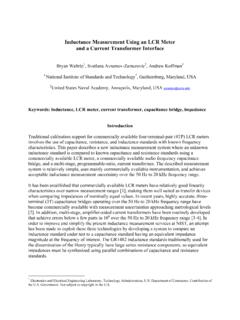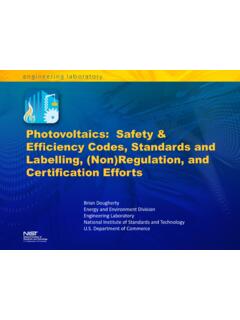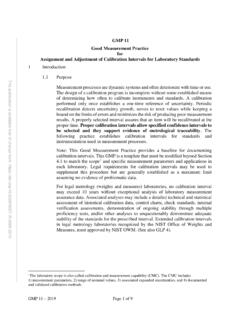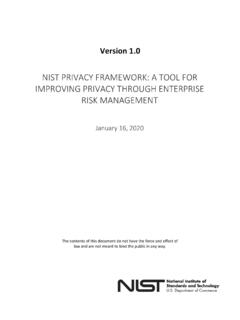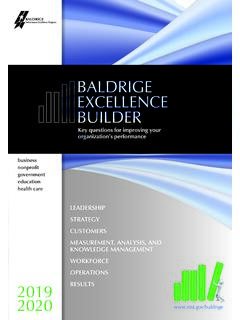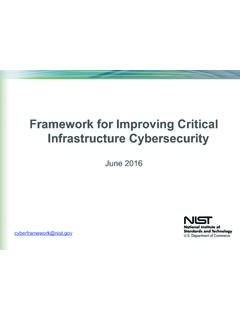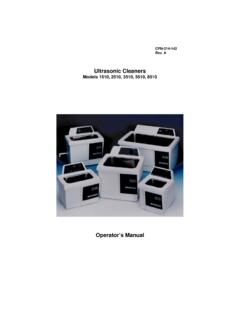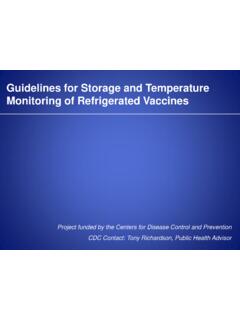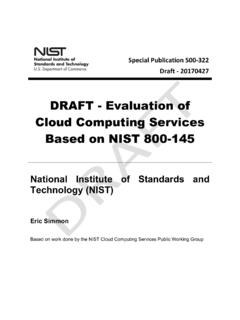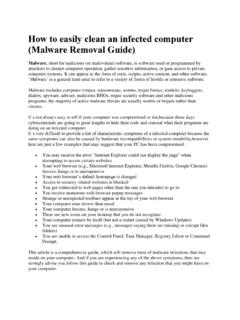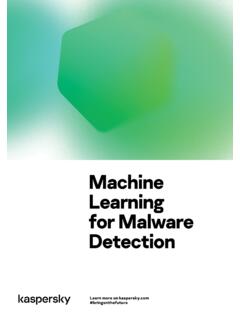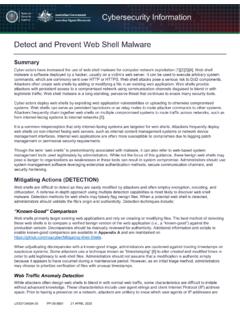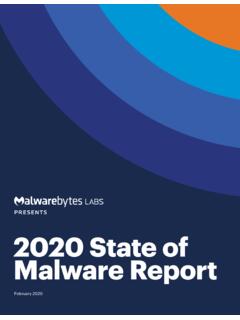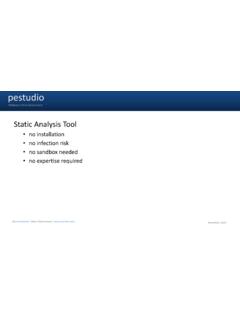Transcription of MALWARE RISKS AND MITIGATION REPORT - NIST
1 MALWARE RISKS AND MITIGATION REPORT June 2011 BITS A DIVISION OF THE FINANCIAL SERVICES ROUNDTABLE 1001 PENNSYLVANIA AVENUE NW SUITE 500 SOUTH WASHINGTON, DC 20004 202-289-4322 BITS MALWARE Risk and MITIGATION REPORT BITS/The Financial Services Roundtable 2011. All Rights Reserved. 2 Table of Contents 1. Executive Summary ..3 2. MALWARE MALWARE 5 MALWARE Example .. 8 Polymorphic MALWARE ..10 3. MALWARE Supply and Demand .. 10 The MALWARE Industry ..11 MALWARE Supply Beyond 4. MALWARE in Financial Services .. 16 MALWARE Infection Vectors ..18 Installed/Injected by Remote Attacker ..18 Web/Internet Web/Internet Installed by Other Network Portable Media and Devices.
2 21 Coded into FI Software ..22 Social Internal 5. Securing the Situational Awareness ..25 Risk Management ..28 Cross-Industry Anti- MALWARE Roles and Responsibilities ..31 6. Conclusion .. 36 7. Appendices A. Terms and Definitions ..38 B. Acronyms ..39 C. D. Citations ..41 1. Executive Summary MALWARE is an abbreviation of the words malicious and software. The term refers to software that is deployed with malicious intent. MALWARE is easy to deploy remotely, and tracking the source of MALWARE is hard. This combination has enabled commercial MALWARE providers to supply sophisticated black markets for both MALWARE and the information that it collects. Demand for sophisticated MALWARE is created primarily by organized crime syndicates and state-sponsored espionage agents.
3 The financial services industry is a primary target for MALWARE -enabled cyber attacks because financial institutions (FIs) operate software that tracks ownership of monetary assets. Cybercriminals also directly target FI customers and business partners using MALWARE -enabled attacks. This paper is intended to assist financial institutions by promoting awareness and understanding of the RISKS and the MITIGATION activities associated with the use of MALWARE in the financial industry. This REPORT is composed of six (6) sections and four (4) appendices, beginning with this executive summary: - Section 2 provides a brief historical overview of MALWARE . It demonstrates that MALWARE has evolved side-by-side with software technology and that this co-evolution may be expected to continue. It provides examples of how MALWARE is deployed in critical infrastructure.
4 - Section 3 describes the criminal organizational structure that supports MALWARE creation and distribution. It highlights negative consequences for the financial industry that result from the existence of this criminal infrastructure, which includes its expanded use for the purposes of nation-state espionage and sabotage. - Section 4 lists cyber attack methods that are known to have utilized MALWARE to damage financial services. - Section 5 describes ways in which the financial sector, in collaboration with technology and business partners, may thwart MALWARE -enabled cyber attacks. 2. MALWARE Evolution Software-enabled crime is not a new concept [1]. Computer-enabled fraud and service theft evolved in parallel with the information technology that enabled it. Since the advent of mainframe-based automated bank account systems, FIs have been victims of MALWARE -based cyber attacks.
5 Criminals altered software to transfer other people s money to accounts they controlled, and emptied the accounts anonymously. As computers were shared on networks, these services experienced service theft, wherein criminals altered system software to hide reconnaissance activities which enabled theft of both valuable services and valuable information [2]. BITS MALWARE Risk and MITIGATION REPORT This co-evolution of technology services and cybercrime may have created some confusion in the general population, for whom attacks on technology do not seem to be as significant as attacks on physical assets. Those not familiar with the emerging technology itself find it difficult to understand the implications of software compromise. General confusion over cybercrime objectives is exacerbated by the element of opportunism in some types of cybercrime, wherein attackers do not select specific victims, but simply let rogue software loose to find its own targets.
6 This type of cybercrime appears to some segments of the public as bad luck for the victim rather than as a direct result of adversarial intent. Nevertheless, even opportunistic cybercriminals select their targets, if only by selecting the operating system platform on which MALWARE may be processed. Where the platform is the latest version of an emerging technology, the selected victim class may be assumed to be those financially able to afford that new technology. Another selection made by cybercriminals is the specification of data that MALWARE processes. Where data concerning credit card numbers is sought, the target victim class includes all credit card holders and associated institutions. Where the data sought is bank account numbers, all financial firms are targets. The attraction of cybercrime lies in the high return on investment, low-to-no-risk operating environments, and proliferation of vulnerable computing resources.
7 The ubiquitous connectedness provided by the Internet has allowed for multiple elements of the criminal community to operate in tandem to pursue profit driven crime as well as other malicious activities, using MALWARE . To the casual observer, headlines about cyber attacks may seem unrelated. Attacks are scattered across geography and technology. They involve different companies and nationalities. As recently as five years ago, security standards publications identified MALWARE and phishing attacks as separate threats [3]. However, today security analysts agree that various types of MALWARE are used in conjunction [4]. Cooperation and collaboration among cybercriminals have created crime patterns that evolve in concert with emerging technology, and all users of emerging technology are victims.
8 There is also evidence that cybercriminals operate in geopolitically-identifiable groups. As one analyst put it, the phrase campaign is more appropriate than adversary [5]. MALWARE is typically used to steal information that can be readily monetized, such as login credentials, credit card and bank account numbers, and intellectual property such as computer software, financial algorithms, and trade secrets. Although many cybercriminal groups are trafficking in commodities shared by multiple industry sectors, such as credit card numbers, there are some situations wherein a single company is obviously the target of a single adversary, whether it be an organized crime syndicate, nation-state, or a single operative. For example, the work of a single nation-state adversary was evident to Google upon analysis of its 2009 cyber attack [6].
9 The extent to which any given attack lands on one set of companies or customers rather than another depends on a variety of factors. These factors are explained in Section 4 of this REPORT . Just as information technology software tools and techniques have become more proficient, more effective, and more economical over time, MALWARE crime patterns have become more finely tuned. BITS/The Financial Services Roundtable 2011. All Rights Reserved. 4 BITS MALWARE Risk and MITIGATION REPORT MALWARE creation and distribution channels are described in detail in Section 3. The remainder of this section describes in general how MALWARE works and how it accomplishes crime. MALWARE Categories MALWARE may take as many forms as software. It may be deployed on desktops, servers, mobile phones, printers, and programmable electronic circuits.
10 Sophisticated attacks have confirmed data can be stolen through well written MALWARE residing only in system memory without leaving any footprint in the form of persistent data. MALWARE has been known to disable information security protection mechanisms such as desktop firewalls and anti-virus programs. Some even have the ability to subvert authentication, authorization, and audit functions. It has configured initialization files to maintain persistence even after an infected system is rebooted. Upon execution, sophisticated MALWARE may self-replicate and/or lie dormant until summoned via its command features to extract data or erase files. A single piece of MALWARE is generally described by four attributes of its operation [7]: Propagation: The mechanism that enables MALWARE to be distributed to multiple systems Infection: The installation routine used by the MALWARE , as well as its ability to remain installed despite disinfection attempts Self-Defense: The method used to conceal its presence and resist analysis, these techniques may also be called anti-reversing capabilities Capabilities: Software functionality available to MALWARE operator Table 1 lists some examples of MALWARE in the context of this taxonomy.
